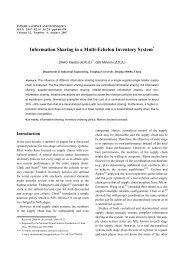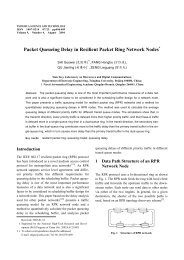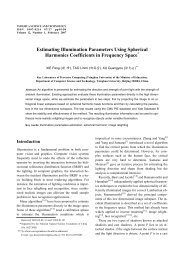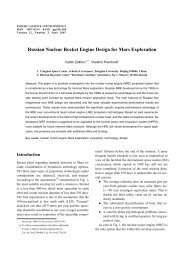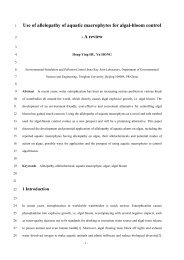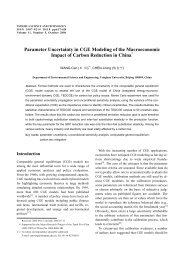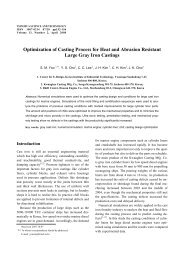Coordination by Option Contracts in a Retailer-Led Supply Chain with
Coordination by Option Contracts in a Retailer-Led Supply Chain with
Coordination by Option Contracts in a Retailer-Led Supply Chain with
You also want an ePaper? Increase the reach of your titles
YUMPU automatically turns print PDFs into web optimized ePapers that Google loves.
578<br />
factor <strong>in</strong> models consider<strong>in</strong>g demand update is how the<br />
market signal updates the demand <strong>in</strong>formation, i.e.,<br />
how to def<strong>in</strong>e F( x| ε ) . Make the follow<strong>in</strong>g assumptions<br />
related to the market signal:<br />
(1) The market signal does not change the demand<br />
distribution pattern, i.e., F( x| ε ) is still uniform.<br />
(2) The market signal only affects the mean of the<br />
demand distribution, not the variance. As the signal<br />
becomes stronger the mean shifts up accord<strong>in</strong>gly. For<br />
uniform distributions, this implies that if F( x| ε ) ~<br />
U( f1( ε ), f2(<br />
ε )), then f2( ε) − f1( ε)<br />
≡b−a and f1 ( ε ) and<br />
f2 ( ε ) are both <strong>in</strong>creas<strong>in</strong>g <strong>in</strong> ε .<br />
(3) A market signal as mathematically expected<br />
ma<strong>in</strong>ta<strong>in</strong>s the orig<strong>in</strong>al demand distribution function.<br />
That is, if ε = 0.5t , then F( x| ε ) = F( x)<br />
. Moreover,<br />
assume<br />
F( x| ε )~ U( a−4(0.5 t−ε), b−4(0.5 t−<br />
ε))<br />
.<br />
To avoid un<strong>in</strong>terest<strong>in</strong>g cases, def<strong>in</strong>e a> 2t.<br />
Consider the follow<strong>in</strong>g numerical example. Suppose<br />
the orig<strong>in</strong>al demand distribution is uniform <strong>with</strong><br />
a = 1000 and b = 2000 . The market signal is uniformly<br />
distributed between zero and t = 150.<br />
The cost<br />
parameters are c1= 50, c2= 65, w1= 60, w2= 80, v=<br />
20,<br />
s = 30,<br />
and p = 100 .<br />
For any o 2 ,<br />
p− v+ s<br />
e= p+ s− o .<br />
(1) Calculate e accord<strong>in</strong>g to<br />
(2) Solve for T ( 2)<br />
c2−v 2<br />
o ε .<br />
If β > 0 , εT( o2)<br />
= m<strong>in</strong>{150, ε′ T},<br />
where T<br />
ε′ is determ<strong>in</strong>ed<br />
<strong>by</strong><br />
−1 −1<br />
π R( ε′ T, F (max{ α,0}| ε′ T)) = πR( ε′ T, F ( β | ε′<br />
T))<br />
;<br />
If β 0 , T ( 2)<br />
150. o ε =<br />
⎡<br />
(3) Calculate o 1 accord<strong>in</strong>g to o1 = ⎢G(<br />
εT<br />
( o2))<br />
−<br />
⎣<br />
c2 − c1 ⎤<br />
o2<br />
c2−v ⎥ .<br />
⎦<br />
N<br />
(4) Solve for d 1 .<br />
N<br />
If e+ o1 w1,<br />
d1 ≡ 0 ;<br />
If e+ o1 > w1,<br />
substitute<br />
N<br />
N d1−[ a− 2 t+ ( b−a)max{ α,0}]<br />
ˆ( ε d1<br />
) = (which is<br />
4<br />
N N<br />
derived from Fd ( | ˆ ε( d )) = max{ α,0}<br />
) <strong>in</strong>to<br />
1 1<br />
N ˆ( ε d1<br />
)<br />
N<br />
2 1 1 ∫ 0<br />
2 1<br />
w − w + o + [ e−w −( e− v) F( d | ε)]d G(<br />
ε)<br />
= 0.<br />
Ts<strong>in</strong>ghua Science and Technology, August 2008, 13(4): 570-580<br />
If ˆ( ε d ) < 150,<br />
the results can be directly used.<br />
If ˆ( ε d ) 150,<br />
then<br />
N<br />
1<br />
N<br />
1<br />
N<br />
d 1 is implied <strong>by</strong><br />
150<br />
N<br />
2 1 1<br />
0<br />
2 1<br />
∫<br />
w − w + o + [ e−w −( e− v) F( d | ε)]d G(<br />
ε)<br />
= 0.<br />
(5) Calculate each party’s expected profit.<br />
Figure 1 shows how the retailer’s first-period order<br />
changes as o 2 varies. As expected, the retailer sets<br />
N<br />
d ≡ 0 when 1 1 , e o w<br />
o <br />
1<br />
p− w1+ s<br />
c2v p− c1+ s<br />
+ or equivalently, 2<br />
( − ) = 39.375.<br />
Such an order<strong>in</strong>g behavior<br />
directly <strong>in</strong>fluences each party’s expected profit curve<br />
shown <strong>in</strong> Fig. 2.<br />
Fig. 1 <strong>Retailer</strong>’s optimal first-period order quantity<br />
Figure 2 compares each party’s expected profit after<br />
coord<strong>in</strong>ation <strong>with</strong> that before coord<strong>in</strong>ation which is<br />
shown <strong>by</strong> the benchmark curve. The powerful retailer,<br />
who acts as a contract designer, will never be worse off,<br />
but the results are not so optimistic. The supplier’s expected<br />
profit even becomes negative for some cases!<br />
Notably, <strong>with</strong> these sett<strong>in</strong>gs, the first-best expected<br />
c<br />
profit Π = 221 209.<br />
Before coord<strong>in</strong>ation, however,<br />
Π R = 175 960 and Π S = 16 437. This leaves an improvement<br />
of 28 812 which is almost twice the supplier’s<br />
expected profit before coord<strong>in</strong>ation.<br />
Fig. 2 Expected profit for each party before and after<br />
coord<strong>in</strong>ation



